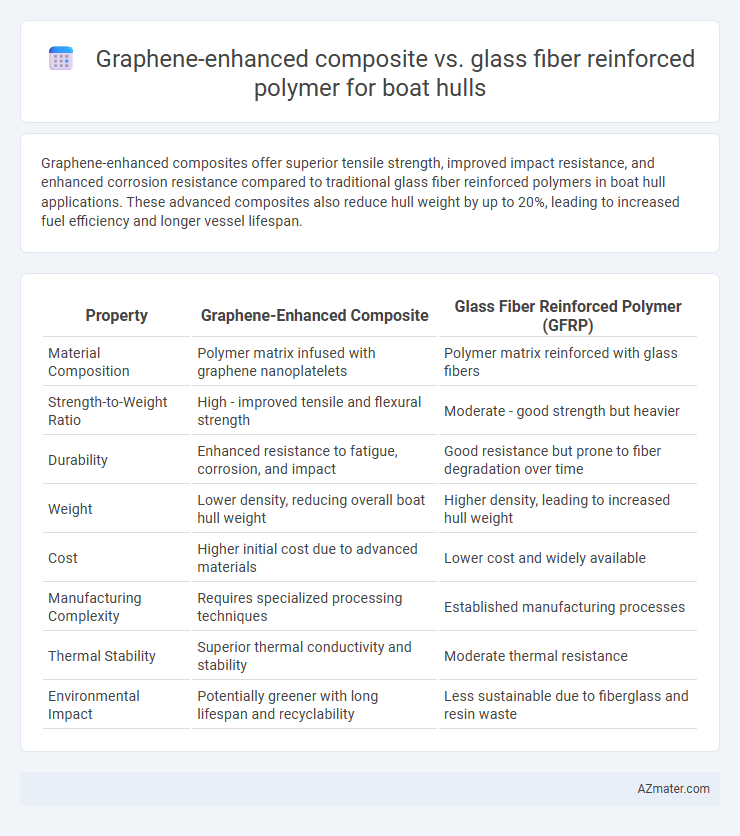Graphene-enhanced composites offer superior tensile strength, improved impact resistance, and enhanced corrosion resistance compared to traditional glass fiber reinforced polymers in boat hull applications. These advanced composites also reduce hull weight by up to 20%, leading to increased fuel efficiency and longer vessel lifespan.
Table of Comparison
| Property | Graphene-Enhanced Composite | Glass Fiber Reinforced Polymer (GFRP) |
|---|---|---|
| Material Composition | Polymer matrix infused with graphene nanoplatelets | Polymer matrix reinforced with glass fibers |
| Strength-to-Weight Ratio | High - improved tensile and flexural strength | Moderate - good strength but heavier |
| Durability | Enhanced resistance to fatigue, corrosion, and impact | Good resistance but prone to fiber degradation over time |
| Weight | Lower density, reducing overall boat hull weight | Higher density, leading to increased hull weight |
| Cost | Higher initial cost due to advanced materials | Lower cost and widely available |
| Manufacturing Complexity | Requires specialized processing techniques | Established manufacturing processes |
| Thermal Stability | Superior thermal conductivity and stability | Moderate thermal resistance |
| Environmental Impact | Potentially greener with long lifespan and recyclability | Less sustainable due to fiberglass and resin waste |
Introduction to Advanced Boat Hull Materials
Graphene-enhanced composites exhibit superior mechanical strength, corrosion resistance, and lightweight properties compared to traditional glass fiber reinforced polymers (GFRP), making them ideal for advanced boat hull applications. The incorporation of graphene significantly improves impact resistance and structural integrity, enhancing durability and performance in marine environments. GFRP remains widely used due to cost-effectiveness but lacks the enhanced thermal conductivity and stiffness offered by graphene-based materials.
Overview of Graphene-Enhanced Composites
Graphene-enhanced composites integrate graphene nanoparticles into polymer matrices, significantly improving mechanical strength, toughness, and corrosion resistance compared to traditional materials like glass fiber reinforced polymers (GFRP). These composites exhibit superior stiffness-to-weight ratios and enhanced fatigue resistance, making them ideal for boat hull applications where durability and performance are critical. The incorporation of graphene also enhances thermal and electrical conductivity, offering improved structural health monitoring capabilities in marine environments.
Understanding Glass Fiber Reinforced Polymers (GFRP)
Glass Fiber Reinforced Polymers (GFRP) consist of glass fibers embedded within a polymer matrix, offering high strength-to-weight ratios and excellent corrosion resistance ideal for boat hulls. Their durability in marine environments stems from the polymer's resistance to water absorption, while the glass fibers provide tensile strength and structural integrity. Compared to graphene-enhanced composites, GFRP is more cost-effective but generally exhibits lower mechanical performance and stiffness.
Mechanical Strength: Graphene Composites vs GFRP
Graphene-enhanced composites exhibit significantly higher tensile strength and stiffness compared to glass fiber reinforced polymers (GFRP), making them superior for boat hull applications requiring enhanced mechanical durability. The incorporation of graphene increases impact resistance and fatigue life, outperforming traditional GFRP by reducing crack propagation under stress. This results in boat hulls with improved structural integrity and longer service life while maintaining lightweight characteristics essential for marine performance.
Durability and Corrosion Resistance Comparison
Graphene-enhanced composites exhibit significantly higher durability than glass fiber reinforced polymers (GFRP) due to graphene's exceptional tensile strength and crack resistance, enhancing the hull's structural integrity under mechanical stress. In terms of corrosion resistance, graphene's impermeable atomic structure provides superior protection against moisture and chemical degradation, reducing water absorption and electrochemical reactions that commonly deteriorate GFRP in marine environments. This results in prolonged service life and reduced maintenance costs for boat hulls made with graphene-enhanced composites compared to traditional glass fiber materials.
Weight and Efficiency: Performance Impacts
Graphene-enhanced composites offer significantly lower weight compared to traditional glass fiber reinforced polymers (GFRP), resulting in improved boat hull buoyancy and fuel efficiency. The superior strength-to-weight ratio of graphene composites enhances hull rigidity and impact resistance while reducing overall vessel mass. These weight savings translate into faster acceleration, increased payload capacity, and extended range, making graphene composites a cutting-edge material for high-performance marine applications.
Cost Analysis: Initial Investment and Lifecycle
Graphene-enhanced composites for boat hulls offer superior strength-to-weight ratio and corrosion resistance compared to Glass Fiber Reinforced Polymer (GFRP), but their initial investment cost is significantly higher due to advanced material processing and limited large-scale production. Lifecycle cost analysis indicates that graphene composites reduce maintenance frequency and extend hull lifespan, potentially offsetting upfront expenses through lower repair and operational costs. However, GFRP remains cost-effective for budget-sensitive projects due to established manufacturing processes and material availability, making it a prevalent choice despite higher long-term upkeep requirements.
Manufacturing and Processing Differences
Graphene-enhanced composites exhibit superior mechanical strength and electrical conductivity compared to glass fiber reinforced polymer (GFRP), enabling lighter yet more durable boat hulls. Manufacturing graphene composites requires advanced dispersion techniques and precise layering to ensure uniform graphene integration, whereas GFRP processing relies on established methods like hand lay-up or vacuum infusion with relatively simpler handling. The complex curing and alignment needed for optimal graphene performance often increase production time and cost compared to the more straightforward and cost-effective fabrication of glass fiber reinforced polymers.
Environmental Impact and Sustainability
Graphene-enhanced composites offer superior durability and weight reduction compared to glass fiber reinforced polymers (GFRP), leading to lower fuel consumption and reduced carbon emissions over the boat's lifecycle. The production of graphene composites involves fewer toxic chemicals and presents better recyclability potential, minimizing environmental pollution and waste. In contrast, GFRP manufacturing generates significant non-biodegradable waste and relies heavily on energy-intensive processes, contributing to a larger ecological footprint.
Future Trends in Marine Composite Technologies
Graphene-enhanced composites offer superior mechanical strength, enhanced corrosion resistance, and lighter weight compared to traditional glass fiber reinforced polymers (GFRP), making them increasingly attractive for future boat hull designs. Emerging trends focus on integrating graphene's exceptional electrical conductivity and thermal stability to improve hull durability and enable smart sensing capabilities for real-time structural health monitoring. Advancements in scalable manufacturing techniques aim to reduce costs and facilitate widespread adoption of graphene composites in marine applications, potentially revolutionizing the next generation of high-performance, eco-friendly boat hull materials.

Infographic: Graphene-enhanced composite vs Glass fiber reinforced polymer for Boat hull
 azmater.com
azmater.com